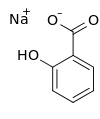Sodium salicylate
Sodium salicylate is a sodium salt of salicylic acid. It can be prepared from sodium phenolate and carbon dioxide under higher temperature and pressure. Historically, it has been synthesized by refluxing methyl salicylate (wintergreen oil) with an excess of sodium hydroxide.[4]
 | |
| Names | |
|---|---|
| IUPAC name
Sodium salicylate | |
| Other names
Salsonin, Monosodium salicylate, Sodium o-hydroxybenzoate, Sodium 2-hydroxybenzoate, Salicylic acid sodium salt, Monosodium 2-hydroxybenzoate, Diuratin | |
| Identifiers | |
3D model (JSmol) |
|
| ChEMBL | |
| ChemSpider | |
| DrugBank | |
| ECHA InfoCard | 100.000.181 |
| EC Number |
|
| KEGG | |
PubChem CID |
|
| RTECS number |
|
| UNII | |
CompTox Dashboard (EPA) |
|
| |
| |
| Properties | |
| C7H5NaO3 | |
| Molar mass | 160.104 g·mol−1 |
| Appearance | white crystals |
| Melting point | 200 °C (392 °F; 473 K) |
| 25.08 g/100 g (-1.5 °C) 107.9 g/100 g (15 °C) 124.6 g/100 g (25 °C) 141.8 g/100 g (78.5 °C) 179 g/100 g (114 °C)[1] | |
| Solubility | soluble in glycerol, 1,4-Dioxane, alcohol[1] |
| Solubility in methanol | 26.28 g/100 g (15 °C) 34.73 g/100 g (67.2 °C)[1] |
| Pharmacology | |
| N02BA04 (WHO) | |
| Hazards | |
| Main hazards | Harmful |
| GHS pictograms |  |
| GHS Signal word | Warning |
GHS hazard statements |
H314, H331, H400[2] |
| P210, P261, P273, P280, P305+351+338, P310[2] | |
| Eye hazard | Irritant |
| NFPA 704 (fire diamond) | |
| 250 °C (482 °F; 523 K) | |
| Lethal dose or concentration (LD, LC): | |
LD50 (median dose) |
930 mg/kg (rats, oral)[3] |
Except where otherwise noted, data are given for materials in their standard state (at 25 °C [77 °F], 100 kPa). | |
| Infobox references | |
Properties
Sodium salicylate is of the salicylate family and this compound is known to trigger Reye's Syndrome in children and adults, usually following a viral infection such as influenza or chicken pox. Products containing such salicylates should not be given to children under the age of 19.
Uses
It is used in medicine as an analgesic and antipyretic. Sodium salicylate also acts as non-steroidal anti-inflammatory drug (NSAID), and induces apoptosis in cancer cells [5][6][7] and also necrosis.[8] It is also a potential replacement for aspirin for people sensitive to it. It may also be used as a phosphor for the detection of vacuum ultraviolet radiation and electrons.[9]
References
- "sodium salicylate". chemister.ru. Retrieved 8 April 2018.
- Sigma-Aldrich Co., Sodium salicylate. Retrieved on 2014-05-26.
- Chambers, Michael. "ChemIDplus - 54-21-7 - ABBQHOQBGMUPJH-UHFFFAOYSA-M - Sodium salicylate [USP:JAN] - Similar structures search, synonyms, formulas, resource links, and other chemical information". chem.sis.nlm.nih.gov. Retrieved 8 April 2018.
- Lehman, J.W., Operational Organich Chemistry, 4th ed., New Jersey, Prentice Hall, 2009
- Klampfer, Lidija; Jörg Cammenga; Hans-Georg Wisniewski; Stephen D. Nimer (1999-04-01). "Sodium Salicylate Activates Caspases and Induces Apoptosis of Myeloid Leukemia Cell Lines". Blood. 93 (7): 2386–94. doi:10.1182/blood.V93.7.2386. PMID 10090950.
- Rae, Colin; Susana Langa; Steven J. Tucker; David J. MacEwan (2007-07-31). "Elevated NF-κB responses and FLIP levels in leukemic but not normal lymphocytes: reduction by salicylate allows TNF-induced apoptosis". Proceedings of the National Academy of Sciences of the USA. 104 (31): 12790–5. doi:10.1073/pnas.0701437104. PMC 1937545. PMID 17646662.
- Stark, Lesley A.; et al. (May 2007). "Aspirin activates the NF-κB signalling pathway and induces apoptosis in intestinal neoplasia in two in vivo models of human colorectal cancer". Carcinogenesis. 28 (5): 968–76. doi:10.1093/carcin/bgl220. PMID 17132819. Retrieved 2011-02-21.
- Schwenger, Paul; Edward Y. Skolnik; Jan Vilcek (1996-04-05). "Inhibition of Tumor Necrosis Factor-induced p42/p44 Mitogen-Activated Protein Kinase Activation by Sodium Salicylate". The Journal of Biological Chemistry. 271 (14): 8089–94. doi:10.1074/jbc.271.14.8089. PMID 8626494.
- Samson, James. "Vacuum Ultraviolet Spectroscopy" (PDF). Pied Publications. Archived from the original (PDF) on October 16, 2006. Retrieved July 26, 2012.
External links
| Wikimedia Commons has media related to Sodium salicylate. |
